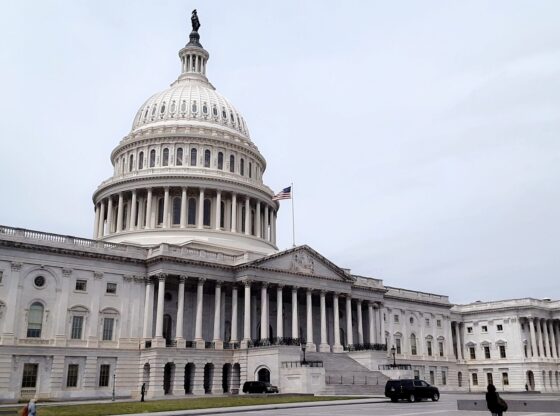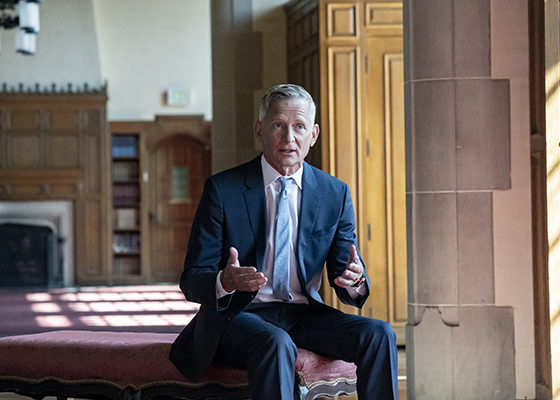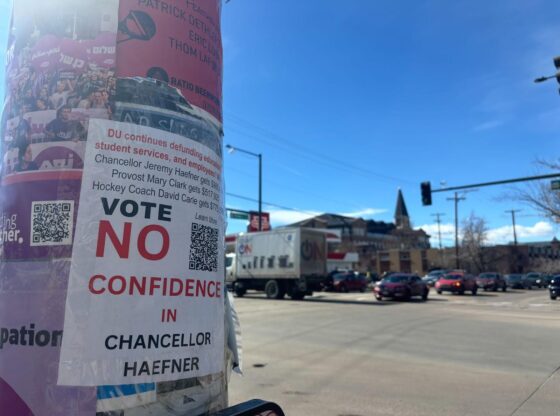Editor’s Note: This letter was republished with permission from the John Evans Study Committee. It has been adjusted for formatting and readability by the editors of The Clarion. It can be originally found on their portfolio here.
To Chancellor Jeremy Haefner, Provost Mary Clark and the Board of Trustees,
We, the undersigned, represent the original faculty members of the John Evans Study Committee of the University of Denver (hereafter “Evans Committee”), the scholars that issued the report on the role of John Evans in the Sand Creek Massacre and the corresponding set of recommendations in November 2014.¹
This letter is in response to Chancellor Jeremy Haefner’s message to the DU community on Oct. 21, 2020, specifically Section VII in which the retention of the “Pioneer” moniker as a guiding symbol for the University of Denver community was made known.
The position of the Evans Committee on the issue is as follows:
- The ongoing assertion of the appropriateness of the Pioneer moniker as a representative figure of the DU community constitutes a dangerous and irresponsible dismissal of our own institutional history, one that cannot be disentangled from the violent legacies of the settler pioneer myth and the results of the Sand Creek Massacre.
- To retain and reassert the Pioneer as a guiding symbol of our institution delivers an especially hurtful message to our Native and Indigenous students and colleagues, as well as our Cheyenne and Arapaho community partners, that their experiences and histories are unimportant when it comes to DU’s conception of its brand.
- Given that, for years now, members of the DU Native community and their allies have respectfully requested to replace the Pioneer with a more appropriate and inclusive symbol, DU is in violation of its own stated values of diversity and inclusive excellence with the stubborn reassertion of the Pioneer as the only possible option of institutional representation.
- The unilateral declaration of this decision as “final” without having ever convened a public forum or process for students, faculty, alumni, administration and staff to engage in open dialogue and deliberation around this issue is insulting and contrary to the values higher education is supposed to embody.
While there was much to commend in the Chancellor’s email, and we recognize the many steps forward being made to render DU a more inclusive community for Native, Black and other students of color, the retention of the Pioneer seems to be a direct contradiction to those gains.
We acknowledge that for some in our community, it can be hard to let go of a symbol that holds meaning, memory and a sense of identity for them. Nonetheless, the members of the Evans Committee support continuing efforts to create a more inclusive guiding symbol. It is long past time to let go of attachment to the fraught and illusory pioneer myth and move forward with a spirit of honest reckoning and healing.
Context for Our Position
The 1864 Sand Creek Massacre is one of the most egregious examples of settler colonial violence against Native American peoples in United States history, and the only one the United States Government has recognized as a massacre and crime at the time of its occurrence. This recognition is emphasized by the fact that the place where the massacre was perpetrated is the only massacre site the National Park Service maintains as a place of historical importance, recognition and commemoration.
It was a brutal attack carried out by U.S. military forces, which included federalized volunteer troops, against peaceful Cheyenne and Arapaho communities who had been promised protection by military officials. From early dawn through late afternoon on a freezing late-November day, over 200 people were slaughtered, most of them elderly, women, children and infants.
The massacre was rife with atrocities. According to soldiers’ accounts, including some who refused to participate and later wrote to Congress in protest, body parts were cut off the slain and later paraded about and displayed in Denver as the spoils of “war.”
The massacre was considered to have violated even the military standards of the Civil War era. This is indicated by the conclusions of three federal investigations into the massacre in 1865. The U.S. has never denied responsibility for the massacre; in the Treaty of Little Arkansas, ratified in 1867, the government promised land and cash reparations to the impacted Cheyenne and Arapaho families. Those reparations have never been paid.
The Sand Creek Massacre is a deep collective wound that Cheyenne and Arapaho people and many other Native Americans carry regardless of tribal origins. It exemplifies some of the most glaring injustices of the American settler-colonial empire. Thus, its relevance to Native communities is central, not peripheral.
Today, the Arapaho and Cheyenne people are spread among three nations on reservations in Oklahoma, Wyoming and Montana. In 2013, as they were preparing for the annual commemoration of the Massacre, the university looked toward the sesquicentennial of its founding.
The Evans Committee formed as an independent, faculty-driven committee whose vital purpose was the assessment of John Evans’ legacy at the University of Denver. This effort seemed especially important during an anniversary year that potentially lent itself to uncritical celebration. Such an endeavor had not previously been attempted to any significant extent.²
Our committee’s goal was to promote a more accurate and honest understanding of the context of our institutional history, without shying away from directly addressing the links between settler violence and DU’s establishment, including the role of prominent founders.
Our work was acknowledged and, in part, funded by then Chancellor Coombe and Provost Kvistad (though it was not an officially appointed committee that reported to them). It was guided throughout by critical input from official representatives of the Arapaho and Cheyenne descendant communities directly affected by the massacre, who also served as active participants in our considerations as committee members.
Investigating John Evans’ role in the massacre was a long overdue enterprise given that he not only served as Territorial Governor—the top political official in the Colorado Territory—from 1862-65, but he also held the coterminous position of Ex-Officio Superintendent of Indian Affairs over the same jurisdiction. In these capacities, both U.S. historians and Cheyenne and Arapaho oral traditions have noted that Evans played a significant role in the events leading up to the massacre.
The vital question the Evans Committee hoped to determine—if possible—was whether he bore any direct responsibility for the massacre that took place. As a result of more than a year of research and careful historical analysis in which Cheyenne and Arapaho stories were also fairly considered, we determined that John Evans bore a significant level of culpability for the massacre.
In his role as the Superintendent of Indian Affairs, Evans neglected his treaty-making responsibilities with Colorado Native nations during a period of rising tensions in 1862-63. As Governor, he engaged in reckless decision-making that put Cheyenne and Arapaho peoples in harm’s way.
He incited and incentivized settler pioneers to partake in violent attacks on the Native peoples residing and traveling in Colorado territory throughout 1864. He forfeited a tangible opportunity to broker peace at the request of Cheyenne and Arapaho leaders in September 1864. He lobbied the War Department for the mustering of troops that were ultimately deployed by Colonel John Chivington to carry out the massacre.
His actions were regarded as irresponsible even by the standards of the time. Evans’s political career was destroyed by the conclusions of the congressional hearings into the massacre. (The full report and background materials are available here.)
The release of the Evans Committee Report was a significant step for the DU community in coming to terms with its past. It also garnered statewide and national media attention. It was directly referenced by Governor John Hickenlooper when he issued a resolution specifying an official formal apology by the State of Colorado on behalf of the Governor’s Office for the massacre at the closing ceremony of the Commemoration of the 150th Anniversary of the Sand Creek Massacre in December 2014. This was an unprecedented act in American history and one taken only after getting the unanimous support of all of Colorado’s living former governors.
This report and its impacts subsequently led to the creation of the Task Force on Native American Inclusivity convened by Chancellor Chopp. A report by that committee led to additional significant changes across the university, many of which were among those recently celebrated in Chancellor Haefner’s letter.
“Pioneer” is Embedded with Legacies of Violence
The term “pioneers” was originally used as a military term for “grunts” who were sent on ahead into “enemy” territory to prepare the way for the ranks of soldiers to come. Despite whatever other associations one might like to draw from the term pioneer, violence has been at the core of the word’s origins in the United States.
To associate it only with the likes of astronauts and scientists is to attempt to obscure its links to American history—and to our own regional and local history—behind a facade of shallow platitudes. In light of the Evans Report findings, there can be no legitimate rationale for rescuing the “better connotations” of Pioneer from its violent legacies in the case of DU.
The administration argues that it is possible to “denounce the tragic violence and injustice against Native people denoted by the term ‘pioneer,’” while embracing the word’s more noble connotations with innovation and bold action. This selective invocation of meaning may be an option for some institutions, but it is inappropriate for one with such intimate links to colonialist oppression and violence, in particular (though certainly not limited to) the Sand Creek Massacre.
The founding of the Colorado Seminary in March 1864 is entwined not just with John Evans, the man with the greatest political connection to the massacre, but also with the Methodist Minister and Colonel John Chivington, who directed its military execution and oversaw its worst atrocities. Chivington himself was a signatory to the original charter for the Colorado Seminary.
People may disagree over how to characterize Evans’s culpability in the Sand Creek Massacre, but Chivington’s role is indisputable. His connection to our founding cannot and should not be erased, minimized or forgotten. The temporal connections are also relevant: Colorado Seminary opened its doors on Nov. 14, a scant two weeks before the massacre took place.
In the parlance of Western settlement at the time, Chivington was considered an “exterminationist,” a supporter of genocidal policy against Native peoples. Evans preferred to move Indigenous peoples to reservations where they could be “civilized” in the mold of farmers and ranchers. While different in practice, these two approaches carry the same anti-Native worldview that most settler “pioneers” carried at the time. Evans himself was unrepentant about these matters.
In an interview with the historian H.H. Bancroft in 1884, he specifically rejected the notion that the lands Native communities had inhabited for centuries belonged to them. Nor, in his view, was the loss of life at Sand Creek worth reconsidering.
Rather, he told Bancroft, “the benefit to Colorado of that massacre, as they call it, was very great, for it ridded the plains of the Indians (sic) for there was a sentiment that the indians (sic) ought not to be left in the midst of the community. It relieved us very much of the roaming tribes of Indians.”
Let’s Choose Courage Over Convention
The suggestion in the Chancellor’s email that a “final,” unilateral decision on this issue can end the conversation—a conversation that, in fact, the university has never bothered to curate and lead in any all-campus public forum or deliberative process—is also an affront to the enterprise of higher education. The conversation will continue with or without the administration’s participation. Yet, it shouldn’t have to be this way.
We are now at another critical juncture when we have the opportunity to choose the courageous and principled path in continuing to create a more inclusive community consistent with the university’s own stated values. American citizens are engaging in a national reckoning with our history, reconsidering which symbols ought to represent us today and into the future. DU should reconsider the importance of clinging to the Pioneer and the violence and oppression it carries.³
In the years since the Evans Report was released, follow-up initiatives like the Task Force on Native Inclusivity and the Native American Community Liaison and Program Office have made meaningful strides in building processes for commemorating the Sand Creek Massacre. They have incorporated Native community input more fully into our decision-making processes, and they have recruited and retained Native students, staff and faculty for these endeavors.
There is much good news from the Chancellor’s email that we can be proud of. Let us not allow that good work to be undermined by hewing to a polarizing symbol and protesting ignorance of the ongoing damage it leaves in its wake.
Since the release of Evans Report, descendants of John Evans himself have reached out to say they were glad to read the report and finally more fully understand a subject that was often shrouded in whispers within their own families, much like at DU. More than ten members of the Evans family have become active supporters of the Annual Sand Creek Massacre Spiritual Healing Run/Walk Event, which begins the last weekend of November at the massacre site near Eads and ends at the steps of the Colorado Capitol.
During the sesquicentennial year, a group of Evans descendants met to participate in meetings with Cheyenne and Arapaho massacre descendants with a focus on healing. These examples illustrate that it is possible to heal from pioneering settler families without clinging to the unassailability of the Pioneer myth.
The University of Denver says it attempts to do better for its Native and Indigenous community members and partners, students of color and other marginalized populations on our campus. But our leadership should demonstrate consistency with an honest willingness to engage in a process of retiring a symbol that no longer serves and inflicts ongoing damage.
The laws, political policies and military actions carried out in the name of “pioneering the West,” and the ideological justifications behind them, have kept many Americans who hail from settler families from knowing themselves and the legacies of their own history, much less their Indigenous neighbors.
Instead of asking Native community members whose ancestors were sacrificed before the march of American settler pioneers to sacrifice yet again for the sake of our “brand,” the University of Denver should finally lay the Pioneer moniker to rest. We can do better, and indeed we should.
Sincerely,
Members of the John Evans Study Committee at the University of Denver
Faculty signatories
Ramona Beltran
Richard Clemmer-Smith
Tamra Pearson d’Estre?e
Alan Gilbert
Adam Rovner
Dean Saitta
Billy J. Stratton
Tink Tinker
Nancy D. Wadsworth (Chair)
Former student & alumni members
Viki Eagle
Julia Bramante
Amanda Williams
Sara Schwartzkopf











